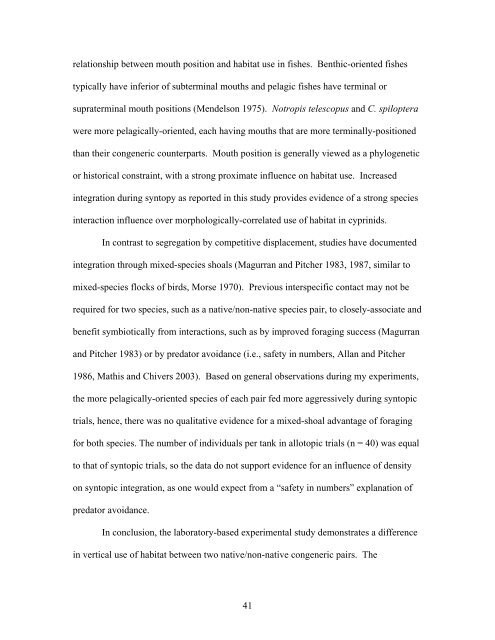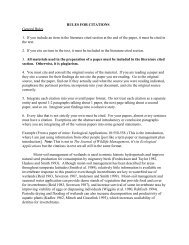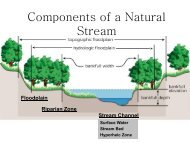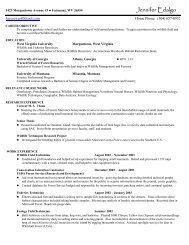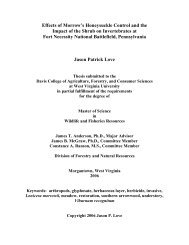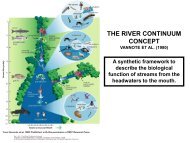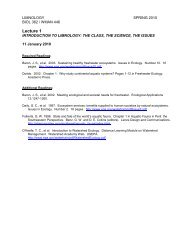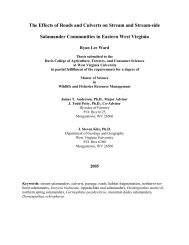An Experimental Study of Vertical Habitat Use and Habitat Shifts in ...
An Experimental Study of Vertical Habitat Use and Habitat Shifts in ...
An Experimental Study of Vertical Habitat Use and Habitat Shifts in ...
You also want an ePaper? Increase the reach of your titles
YUMPU automatically turns print PDFs into web optimized ePapers that Google loves.
elationship between mouth position <strong>and</strong> habitat use <strong>in</strong> fishes. Benthic-oriented fishes<br />
typically have <strong>in</strong>ferior <strong>of</strong> subterm<strong>in</strong>al mouths <strong>and</strong> pelagic fishes have term<strong>in</strong>al or<br />
supraterm<strong>in</strong>al mouth positions (Mendelson 1975). Notropis telescopus <strong>and</strong> C. spiloptera<br />
were more pelagically-oriented, each hav<strong>in</strong>g mouths that are more term<strong>in</strong>ally-positioned<br />
than their congeneric counterparts. Mouth position is generally viewed as a phylogenetic<br />
or historical constra<strong>in</strong>t, with a strong proximate <strong>in</strong>fluence on habitat use. Increased<br />
<strong>in</strong>tegration dur<strong>in</strong>g syntopy as reported <strong>in</strong> this study provides evidence <strong>of</strong> a strong species<br />
<strong>in</strong>teraction <strong>in</strong>fluence over morphologically-correlated use <strong>of</strong> habitat <strong>in</strong> cypr<strong>in</strong>ids.<br />
In contrast to segregation by competitive displacement, studies have documented<br />
<strong>in</strong>tegration through mixed-species shoals (Magurran <strong>and</strong> Pitcher 1983, 1987, similar to<br />
mixed-species flocks <strong>of</strong> birds, Morse 1970). Previous <strong>in</strong>terspecific contact may not be<br />
required for two species, such as a native/non-native species pair, to closely-associate <strong>and</strong><br />
benefit symbiotically from <strong>in</strong>teractions, such as by improved forag<strong>in</strong>g success (Magurran<br />
<strong>and</strong> Pitcher 1983) or by predator avoidance (i.e., safety <strong>in</strong> numbers, Allan <strong>and</strong> Pitcher<br />
1986, Mathis <strong>and</strong> Chivers 2003). Based on general observations dur<strong>in</strong>g my experiments,<br />
the more pelagically-oriented species <strong>of</strong> each pair fed more aggressively dur<strong>in</strong>g syntopic<br />
trials, hence, there was no qualitative evidence for a mixed-shoal advantage <strong>of</strong> forag<strong>in</strong>g<br />
for both species. The number <strong>of</strong> <strong>in</strong>dividuals per tank <strong>in</strong> allotopic trials (n = 40) was equal<br />
to that <strong>of</strong> syntopic trials, so the data do not support evidence for an <strong>in</strong>fluence <strong>of</strong> density<br />
on syntopic <strong>in</strong>tegration, as one would expect from a “safety <strong>in</strong> numbers” explanation <strong>of</strong><br />
predator avoidance.<br />
In conclusion, the laboratory-based experimental study demonstrates a difference<br />
<strong>in</strong> vertical use <strong>of</strong> habitat between two native/non-native congeneric pairs. The<br />
41


